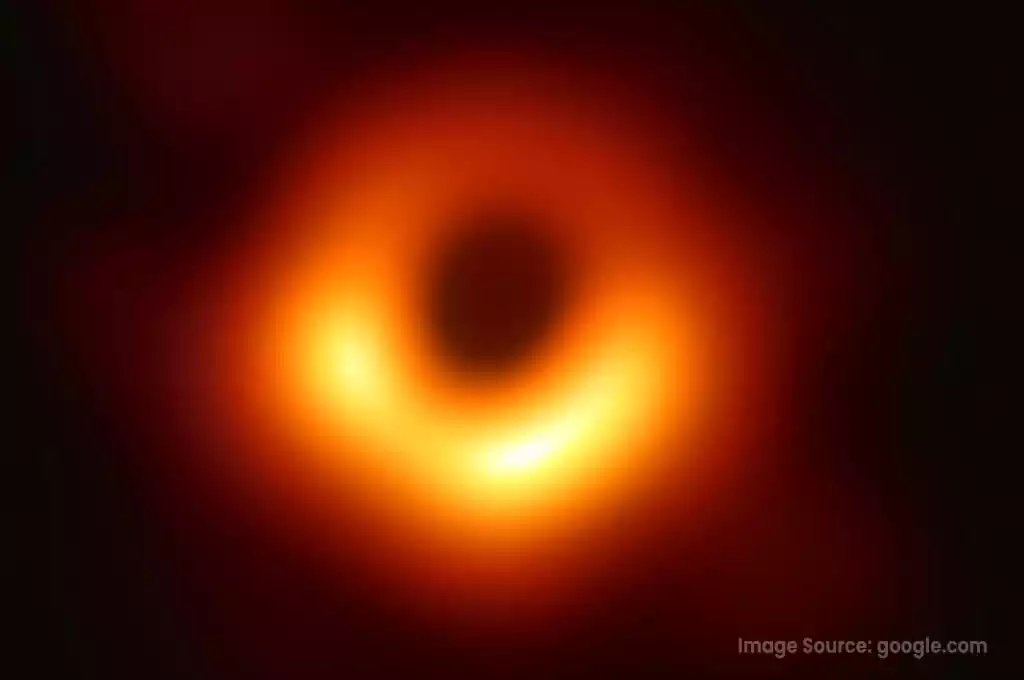The world is seeing the primary-ever photograph first glimpse of a black hole Wednesday, as an international group of researchers from the occasion Horizon Telescope task launched their have a study the supermassive black hole on the center of galaxy Messier 87 (M87).
The photograph suggests a dark disc “outlined by way of emission from warm gasoline swirling round it below the impact of sturdy gravity close to its occasion horizon,” the consortium said.


“As an astrophysicist, that is an interesting day for me,” stated countrywide science basis Director France A. Córdova.
The sizable black hole is some 55 million light-years from Earth inside the Virgo galaxy cluster; with a mass a few 6.5 billion times that of our sun.
“We’re pleased that allows you to file to you today that we have visible what we idea become unseeable. We’ve seen and brought a photo of a black hollow,” said EHT Director Shep Doeleman of Harvard College.
Researchers on the occasion Horizon Telescope task say they were capable of create an image of a black hole via using a network of 8 radio telescopes to create “a virtual telescope dish as big as the Earth itself,” the countrywide science foundation says.
The jump ahead, Doeleman said, got here after a decade of labor to align the myriad running components of the project and benefit the first-rate decision viable from the Earth’s ground. Eventually, in April of 2017, he stated,
“All of the dishes in the event Horizon Telescope swiveled, grew to become and stared” on the core of M87. From that information got here the image that became launched Wednesday.
Córdova and Doeleman led a news convention in Washington, D.C., to talk approximately the group’s locating, in an synchronized way that took place concurrently on 4 continents, as researchers held press meetings to proportion records of what they’re calling ” a groundbreaking end result.”
“You have got probably seen many, many photographs of black holes earlier than,” said Heino Falcke, a professor within the Netherlands who chairs the EHT technological know-how Council.
“However they were all simulations or animations. And this is treasured to anybody, because this one is finally actual.”
Pointing to the display at the ecu studies Council’s news convention in Brussels, Falcke said that the lot-sought-after photo “looks like a hoop of fireplace. And it is really created by way of the force of gravity, by way of the deformation of space-time, in which mild certainly goes across the black hollow, nearly in a circle.”
Describing the photo in Washington, Doeleman stated, and “The brilliant patch within the south … Tells us that fabric transferring across the black hole is moving at light speeds—” based on Albert Einstein’s theories.
As for its broader implications, Doeleman stated that through manner of taking images the photo of a supermassive black hole at the center of a shiny galaxy, “We now recognize in reality that black holes drive massive-scale form within the universe.”
“As with each excellent discoveries, this is just the begin,” he introduced, predicting the image may open new avenues for observe and research.
The newly imaged black hole is some a hundred billion kilometers across.
But regardless of its big size, everybody looking for it inside the night sky from the Earth’s floor would face the same venture in the event that they stood in Brussels and desired to peer a mustard seed in Washington, Falcke said.
It’s well-known that a black hole’s gravity is so overpowering that even slight cannot escape its center. However black holes additionally dramatically affect their surrounding space, most obviously by means of developing an accretion disk — the swirl of gas and cloth that unexpectedly orbits their singularities.
Whilst we now have appropriate oblique proof that they exist, getting an immediate view of a black hole is the closing dream for a whole lot of physicists.”
For years, a leap forward in black hole detection promised to reply a query that has dogged scientists for the reason that Einstein proposed the lifestyles of black holes in his fashionable concept of relativity: How do you file the presence of something its miles invisible?
As it responded that query, the EHT undertaking institution also posted six research papers in the Astrophysical magazine, laying out their approach and findings.
EHT telescopes are arrayed around the world, from Antarctica to Arizona and from Mexico to Spain. Earlier than scientists can take a look at data amassed by means of the use of the network, a painstaking approach want to take location?
Each sign received by way of the telescopes must be synchronized wave by way of wave, using atomic clocks and a supercomputer to correlate and combine observations from around the arena.
It takes many hours of observations to report enough information to create a photograph.
“Like a time-lapse publicity, this slowly builds up a photograph of even a very dim source,” the NSF says. “It additionally allows Earth’s rotation to, in impact; fill inside the empty spaces in the array to supply an extra whole photograph.”
In some weeks of staring at the black hollow, the EHT challenge gathered 5 petabytes of records, which Dan Marrone of the university of Arizona stated changed into equivalent to five,000 years’ worth of mp3 documents — or “the complete selfie series over an entire life for 40,000 people.”
The mission of correlating huge quantities of facts, sifting thru noise, calibrating statistics and creating a usable photo turned into a “very enormous” part of the task, Marrone said.
“They deserve a full-size quantity of credit for their diligence and dedication,” Marrone said, “because without it, we could not have made a photo.”
A number of that work befell in Massachusetts, at MIT’s laptop science and synthetic Intelligence Lab, wherein computer scientist Katie Bouman “led the introduction of a brand new algorithm to provide the first-ever photo of a black hole,” the lab said Wednesday.
Bouman, who become a graduate student while she started out operating on the undertaking, gave a TEDx speak in overdue 2016 wherein she mentioned the project of using algorithms to “piece collectively photos from the sparse, noisy information” from telescopes — without, she delivered, biasing the system to gravitate toward what scientists would possibly assume a black hole to appear like.
To make certain the very last picture’s validity, the EHT assignment used a “blind” procedure, assigning 4 groups to spend seven weeks running independently to create an image based on statistics about the M87 black hole that became accumulated on April 11th.
Once they in comparison the pics, researchers discovered that each one of them depicted a “ring” around the black hole that changed into kind of the identical diameter, with a brighter phase in its southern arc.
Also Read : Elon Musk’s Bold Move: Twitter Logo Change to ‘X’ Sparks Global Interest
To discover a black hole big sufficient to be potentially visible from an Earth-based totally telescope, event Horizon researchers centered on “supermassive” black holes which are observed at the facilities of galaxies. The worldwide collaboration determined to cognizance on the black hole at the middle of galaxy M87 due to its gargantuan size and different characteristics.
“M87 is the nearest galaxy with a supermassive black hole this is generating an effective jet — a lovely streamer product of plasma touring at close to the velocity of light,” stated Charles Gammie, a professor on the college of Illinois at Urbana-Champaign who’s on the EHT science Council Board.
In a data launch about the bounce ahead, Gammie stated: “one of the extremely good mysteries in astronomy has been how such jets are released.
Our simulations, which might be based at the movement of magnetic fields and heat gas close to the black hole, showed that the jets are powered with the aid of using the black hole itself. Magnetic fields act to brake the rotation of the black hole and transfer its rotational strength to the jet.”
As they analyzed the photo and related statistics, astronomers moreover grew increasingly more confident with different assumptions they have got made primarily based on theories approximately the workings of the universe.
“As soon as we had been positive we had imaged the shadow, we may want to examine our observations to substantial laptop models that include the physics of warped area, superheated matter and strong magnetic fields.
Some of the capabilities of the found image healthy our theoretical knowledge exceedingly properly,” stated Paul T.P. Ho, EHT board member and director of the East Asian Observatory.
He delivered, “This makes us confident approximately the interpretation of our observations, which include our estimation of the black hollow’s mass.”
FAQs
What are the signals from a black hole?
Black holes emit various signals, such as X-rays, gamma rays, and radio waves. These signals provide crucial information about their presence and characteristics.
What are the strange radio signals from outer space?
Strange radio signals detected from outer space often originate from celestial objects like pulsars, quasars, and black holes. These signals help astronomers study the universe’s mysteries.
How do radio waves detect black holes?
Radio telescopes capture radio waves emitted by black holes. These telescopes are part of the Event Horizon Telescope project, which recently produced the first-ever image of a black hole.
Is a black hole a radio source?
Yes, black holes can act as radio sources due to the emission of radio waves from the matter swirling around their event horizons.
Can a radio signal escape a black hole?
No, once a radio signal crosses a black hole’s event horizon, it cannot escape the black hole’s intense gravitational pull.
How do scientists detect black holes?
Scientists use various methods to detect black holes, including studying their effects on nearby matter, observing gravitational waves, and capturing their emissions using telescopes.
How do scientists know black holes exist?
The existence of black holes is supported by extensive observational evidence, including the movement of nearby stars and gas, as well as the detection of gravitational waves.
Who discovered black holes?
While the concept of black holes dates back centuries, the term “black hole” was coined by physicist John Archibald Wheeler in 1967. The discovery of black holes has been credited to several astronomers, including Karl Schwarzschild, Subrahmanyan Chandrasekhar, and Roy P. Kerr, who made significant contributions to the understanding of these enigmatic objects.



